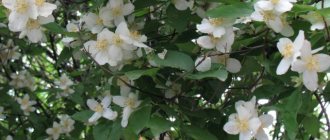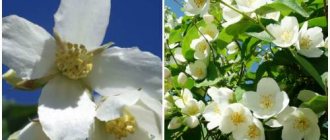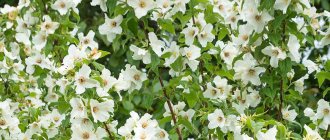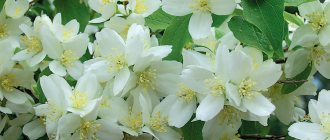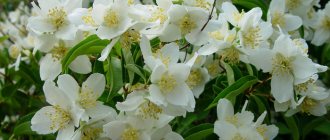Varieties of crown mock orange (Philadelphus coronarius)
In the middle zone, the crown mock orange blooms first - in early June (if the spring is warm, then at the end of May). This shrub grows quite quickly and can reach a height of 3 m. The plant lives for about 30 years. The most commonly cultivated ornamental varieties in gardens are:
Aureus
In spring, this shrub with a spherical crown is decorated with bright yellow leaves, and in summer and autumn they are yellowish-green. Thanks to its bright foliage, this mock orange is decorative all season, and not just during flowering, when it is covered with numerous simple white flowers with yellow stamens in the center, emitting a strong aroma. Mock orange Aureus grows well in sunny areas, and tolerates partial shade, but then blooms sparingly. After flowering it needs sanitary pruning.
Variegatus
This upright shrub reaches a height of 1.5 m. In addition to creamy-white fragrant flowers, it has very attractive slightly serrated leaves (up to 5-9 cm long) of variegated (and some completely white) colors.
Cultivation Secrets
Mock orange is one of the most unpretentious and easy to grow plants. Perhaps this is one of the reasons for such a wide distribution of mock orange in our gardens and parks. Most of its varieties grow well in both sun and partial shade. Mock orange also tolerates the frosty season well. Even if the branches freeze in the harsh winter, new shoots of restoration will emerge from the powerful root system in the spring.
Where to begin?
A sufficiently lit place is most suitable for planting mock orange. It tolerates slight shading well and grows even in the shade, but in such conditions the shoots of the plant become too elongated and flowering will not be abundant. Also, when choosing a place for planting, you should take into account that crown mock orange has a negative attitude towards the proximity of groundwater and stagnation of moisture in the soil.
Planting of seedlings can be done both in the fall, after leaf fall, and in the spring, before the leaves bloom. The depth and width of the planting hole should be at least half a meter, and to cover the root system, it is necessary to stock up on fertile soil or humus: the plant should be provided with soil nutrition for many years of its life.
For a single planted shrub, sufficient free space should be provided. There should be at least one and a half meters of free space around it. When planting plants in a row, in the form of a hedge, you must maintain an interval between bushes of 0.5 m to a meter.
First, drainage is placed at the bottom of the planting hole, then the seedling, spreading the roots evenly in the hole. Then the root system is sprinkled with fertile soil and the soil is well compacted. It is permissible to deepen the root collar by 2-3 cm, but no more, to avoid rotting. Planting is completed by abundant watering and mulching of the tree trunk circle.
How to care?
Caring for mock orange is not difficult. The most important thing for him is maintaining the water regime. As already mentioned, the plant does not tolerate stagnation of water, but it is also sensitive to its lack. Therefore, regular watering should be an important part of caring for mock orange. To ensure that moisture is used evenly, it is advisable to cover the tree trunk circle with a layer of mulch.
Good to know! It is great if compost is used as a mulching material, so the plant will be additionally supplied with organic substances.
In the year of planting, young bushes are not fed, so they take root better. In subsequent years, nitrogen fertilizers are applied at the beginning of the growing season, and phosphorus and potassium fertilizers are applied after flowering.
Corona mock orange bushes do not need systematic pruning: the plant is able to regulate its crown itself, taking on the correct beautiful shape. You just need to trim off the tips of the branches that have faded. This achieves greater decorativeness of the shrub in the summer, and the plant does not waste energy on the formation of fruits and seeds, directing more energy to the formation of flower buds and the development of leaf apparatus. Also, on the eve of winter, it is necessary to remove the unripe parts of the shoots: they will most likely die off in the winter. It is necessary to thin out and rejuvenate bushes that have been growing for a long time, in which the bush has become irregular in shape and some branches have become bare.
Varieties of Lemoine mock orange (Philadelphus lemoinei)
The French gardener Lemoine made a significant contribution to the spread of mock orange throughout the world, so an entire species is named after him. It includes hybrids of common mock orange and small-leaved mock orange. Lemoine mock orange is widespread in countries with temperate climates. True, plants of foreign selection are less winter-hardy, therefore they are more often cultivated in regions with a milder climate. However, they are so attractive that even in the middle zone, some gardeners are not lazy to grow these garden jasmines with winter shelter. They bloom in late June and July.
Virginal
This hybrid mock orange is also called maiden, virgin or innocent. The bush reaches a height of 2 m. During flowering, it is strewn with fragrant double flowers (about 5 cm in diameter), which are collected in inflorescences of 5-7 pieces.
Avalanche, or Avalanche
This mock orange has the smell of strawberries, which is why people often call it strawberry. The shrub (about 1.5 m high) has thin brown shoots, narrow light green leaves (2 cm long) and many simple white flowers (up to 3 cm in diameter), which are located in 1-3 pieces on short axillary shoots and exude a pleasant strawberry aroma. Lush flowering is observed in July.
The disadvantage of this plant is that it cannot withstand frosts below –15°C.
snow avalanche
Since the Avalanche variety turned out to be insufficiently winter-hardy for the middle zone, breeder N.K. Vekhov improved it and obtained an early-flowering winter-hardy variety, which he named Snow Avalanche. This is a more graceful shrub up to 1.5 m high with curved flowing branches, green leaves up to 4 cm long and numerous semi-double flowers (up to 3 cm in diameter), smelling of strawberries.
Moth Ballet
This variety is often mistakenly called Flight of Moths. A tall and powerful shrub is attractive for its asymmetrical shape of semi-double flowers of cream color and with a delicate aroma. The inflorescences protrude slightly above the leaves, so it seems that white butterflies are circling around the bush.
Airborne assault
On a compact bush (about 1.4 m high), thin branches bend under the weight of inflorescences (8-9 cm long) with 7-9 freely arranged small and simple flowers in the shape of a bowl. They resemble parachutes and also smell nice of strawberries.
Firework
A mock orange bush about 2.4 m high is strewn with numerous double flowers (4-4.5 cm in diameter) of white color with a delicate scent.
Komsomolets
The shrub reaches a height of 1.3 m. Its strong stems are located at an angle of 80 degrees. The shoots (about 10 cm long) are slightly curved upward. In mid-summer they are strewn with double flowers (about 4.5 cm in diameter) of snow-white color. The lower petals are oval, the inner ones are narrow and more oblong. Among them, yellow anthers are barely noticeable.
Chamomile
This variety is loved by many gardeners due to the unusual shape of the flowers. They are almost flat and at the same time with narrow and long petals. Externally, these flowers resemble chamomile - hence the name of the variety.
Snow Avalanche, Ballet of Moths, Airborne Assault, Salyut, Komsomolets, Romashka and other varieties of domestic selection are often combined into a group called “Vehova Varieties”. These are the most frost-resistant varieties of mock orange.
Mock oranges with two-color flowers are very decorative.
Bicolore
This plant has white flowers (about 5 cm in diameter) with a pink-burgundy core and golden stamens.
Caring for Jasmine Variegatus
Caring for the crowned mock orange will not cause much trouble, but you also need to devote time to caring for it. Even the most unpretentious plant needs periodic watering, fertilizing, mulching and thinning.
Important! Don’t forget about weekly weed removal and loosening of stagnant soil.
Experienced gardeners also recommend carrying out rejuvenating and formative pruning to ensure that the bush grows properly and forms a lush crown without losing its decorative appearance.
Proper watering
A young seedling that is gaining strength especially needs abundant watering. A tree trunk circle is made around it and irrigated, maintaining moderate soil moisture. When jasmine “gets older”, the procedure is carried out in accordance with weather conditions.
With a lack of moisture, the leaves of the plant lose turgor (the elasticity of living cells), turn yellow and fall off, and the flowers do not bloom. The shrub should be watered with warm, settled water, avoiding the formation of lime in the soil.
In early spring, before flowering begins, it will be useful to spray the leaves (dissolving the growth stimulants listed above in water), and mulch the tree trunk with a thick layer of peat, which will allow moisture to be retained as long as possible.
Important! It should be remembered that, just like the wateriness of the soil, mock orange does not tolerate drought, so during the hot period (June - July) up to 2 buckets of water are poured under each bush.
Feeding and fertilizer
At the initial stage of formation, the plant is not fertilized, but fertilized in the second year after planting in a permanent place. It is recommended to add mineral and organic substances twice a year - before flowering (April - May) and after (July). Before the leaves bloom, the bush can be watered with mullein infusion prepared in a ratio of 1:10 with water or mineral solutions of urea, potassium and superphosphate (20 g of each component per 10 liters of water).
This will accelerate the growth of mock orange, stimulate its abundant growth and activate flowering. An alternative to the mineral complex can be a mixture of wood ash, which is poured with a bucket of water, left for 3 days and watered on the bush with the solution. This component contains a large number of macro- and microelements, without which normal plant development is impossible.
Important! The second feeding after flowering is done “dry”, introducing mineral components into the soil around the tree trunk.
Lighting
Mock orange is a light-loving plant, but young, immature shoots or cuttings must be shaded from bright sunlight, which can negatively affect the leaves and burn the plant (especially the aggressive spring sun).
After planting the bush in a permanent place, on the contrary, it must be provided with a sufficient amount of light, which provokes the formation of large inflorescences and vigorous flowering. Jasmine growing in shady or windy areas takes on a deformed shape, an elongated crown and small flowers.
Here you can read about the benefits and harms of jasmine tea.
Soil care
In order for air to penetrate into the soil, loosening should be done periodically, especially during periods of prolonged drought. After the procedure, the surface crust is loosened, weed sprouts are destroyed, and the roots of large weeds are dug up.
During the absence of rain in the hot summer months, it is very important to loosen the tree trunk areas so that the soil is saturated with oxygen and releases useful substances to the roots. With proper soil care, the bush grows safely and blooms profusely, so loosening the jasmine to a depth of 3-4 cm will only be beneficial.
Humidity
Mock orange Variegatus does not tolerate long periods of high humidity and does not take root well in damp soils. If your garden area is decorated with jasmine, do not forget to monitor the condition of the soil around it. Drought and prolonged lack of watering can be disastrous for the bush, as a result of which jasmine leaves curl, darken and fall off.
Humid air is tolerated somewhat more easily by the bush. It is moderate air humidity that increases the decorativeness of the plant, so if there is a lack of it, the leaves are sprayed. To do this, use warm, settled water, and perform the process manually for each bush or use the sprinkling method, based on spraying moisture in the form of rain over the plant and the soil surface.
Features of reproduction
New specimens of hybrid mock orange Schneeshturm can be obtained in the following ways:
- seeds;
- green or woody cuttings;
- layering;
- dividing the bush.
When planted with seeds, young seedlings are grown in seedling beds and young plants are planted in a permanent place only in the 2nd - 3rd year. Planting with cuttings is better suited for small-leaved rather than large-leaved mock oranges, to which the Shneeshturm variety belongs. Cuttings grow rather slowly and require a lot of patience and diligence from the gardener. But in the end, you can get high-quality planting material with all the properties inherent in this type of plant. The method of dividing bushes is the simplest for propagating garden jasmine and makes it possible to immediately plant the seedlings in a permanent place. Planting in this way can be done in early spring or autumn.
Important! Hybrid mock orange Schneeshturm tolerates transplantation well and quickly takes root in a new place.
Pests and diseases
“False” jasmine variety Schneeshtorm is a plant resistant to diseases and pests. But specific pests appear on weakened bushes growing in unfavorable conditions:
- bean aphid;
- spider mite;
- leaf weevils.
It is better to combat them in the early stages of their development with natural, biological means - infusions or decoctions of herbs. If the lesion has reached a critical size, and folk remedies during treatment have not brought a positive result, fungicides are used to treat mock orange Schneeshturm.




